Every summer, guests travel from around the world to the Columbia Icefield to explore, dine and stay glacier-side. But none of it happens on its own.
At the Glacier Discovery Centre, located about 100 kilometres from the Jasper townsite along the Icefields Parkway, team members across disciplines work to make each experience seamless, responsible and spectacular. Meet the village that helps makes every Columbia Icefield visit remarkable.
Starting in spring, guests head to the Columbia Icefield Adventure to discover the timeless wonder of the Athabasca Glacier and Sunwapta Valley. But before they do, it's Sean Wall's team who's first to arrive, clearing the way for the season to come — a process that's never quite the same twice.
“A lot of preparation for the startup is based on how Mother Nature treated us over the wintertime,” says Wall, director of operations at the Columbia Icefield.
Wall's team is responsible for getting the road and glacier ready for opening day. Some seasons are easier than others — Wall recalls that during his first year, the team had to dig through nearly seven metres (22 feet) of snow to uncover the paved road to the glacier. It took four people, four pieces of equipment and 11 days to get the road leading onto the glacier open.
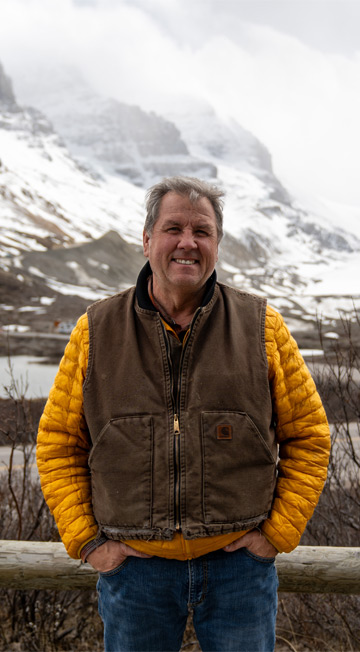
“It's important to realize that the glacier and the lateral moraine and the ice core moraine — they're all one big living creature,” says Wall.
Wall joined the Columbia Icefield team in February 2017. He describes the privilege of working on the glacier (often referred to as the “old girl” by the team) as spiritual, which is why after taking an 18-month sabbatical, he returned in 2023.
“Finally, the old girl called me back,” he says.
Working as part of Wall's team means living in a remote part of the Canadian Rockies with little access to the outside world. The crew of four, including Wall, start their jobs six weeks before opening day to figure out what needs to be done to make the glacier accessible. Team accommodations, referred to as camp, are typically without running water or electricity when they arrive.
For Wall, all that hard work is worth it — and as he explains, it's a group effort. “Not just my team, but the entire team out here at the icefield,” says Wall. “We’re all here for one purpose, and that purpose is to make those memories.”
When guests arrive at the Glacier Discovery Centre, team members like Dylan Meisner and Abhiraj Singh are there to greet them.
“It's really a once in a lifetime opportunity for people to come to the icefield,” says Meisner, director of hospitality at the Columbia Icefield.
“Not everyone gets a chance to come up here, so we do our very best to make their stay memorable,” adds Singh, the manager of Glacier View Lodge and Altitude.
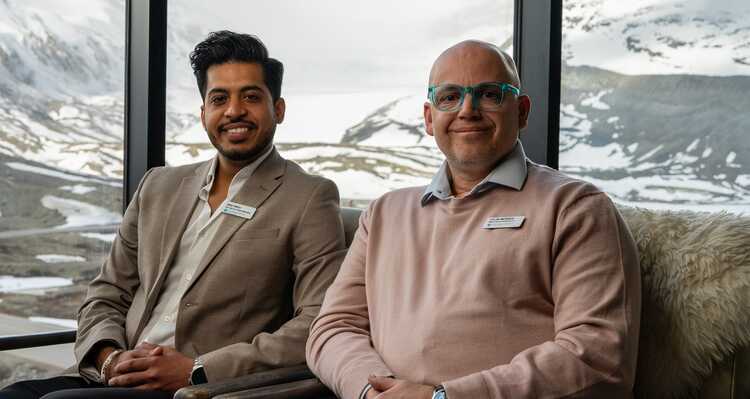
At peak season, the Columbia Icefield team totals 240 people, all responsible for making sure the experience runs smoothly for all guests. Much like the people they serve, the seasonal team comes from all over the world. And whether guests are staying at the hotel, experiencing the glacier or Columbia Icefield Skywalk or even just stopping at the on-site Starbucks, Singh and Meisner agree that every guest deserves the same level of enthusiasm.
“We aim to see the experiences through their eyes,” says Meisner, “so that we're giving them what we would want for ourselves.”
Singh says guests love to learn about the team's experience working in the mountains, from what it's like to wake up with the Athabasca Glacier out your window to the challenges of living off-the-grid in a national park. But this job is more than logistics — the team are also stewards of the environment, the glacier, the park and everything that makes Columbia Icefield special.
“It's important that what guests take away from this is something greater than just having taken a picture or seen some wildlife,” says Meisner.
Seeing the glacier, he says, is “a breathtaking opportunity.” Singh says they aim to make that opportunity as special as they can for guests and team members alike.
“If my guest is leaving with a smile on their face with happy memories, and if my team members are coming back year over year, that just makes me motivated.”
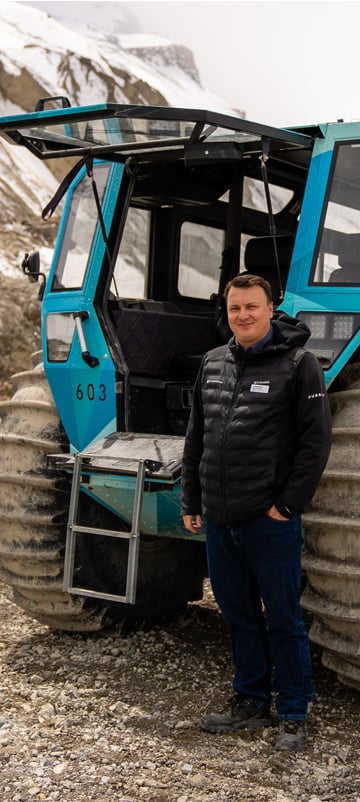
Every day, guests visit the Athabasca Glacier for a one-of-a-kind alpine adventure. Behind the scenes, it's Jon Brennan, senior manager of Glacier Experience and Transportation, who is responsible for getting them there.
Brennan's team consists of about 70 guides that get guests where they need to go. “Some of our guides have been here for 15 to 20 years because they love being able to be in nature, out on the glacier,” says Brennan.
With guests exploring the ice every day, Brennan says sustainability is always front of mind. “The glacier is melting, as everybody kind of knows. Part of what we do is the education piece,” says Brennan, “showing people why glaciers are so important in our environment.”
To ride onto the glacier, guests have two options. The classic Columbia Icefield Adventure features the now-iconic red and white Ice Explorer vehicles, which regularly transport around 50 people to the glacier at a time.
The other ride option is the Ice Odyssey, featuring customized “Fat Truck” vehicles. Guides navigate down the road with a maximum of 10 guests for a more intimate experience. The smaller units have less impact on the glacier and use less fuel than the Ice Explorers.
The Ice Explorers have also been refurbished to run on tier 3 and tier 4 engines, signicantly reducing nitrogen oxide emissions while driving. Both vehicle types are regularly maintained to avoid any spills, but just in case, the team uses ecologically friendly fluids.
In addition to these low impact vehicles, the transportation team recently started an Ice Explorer electrification project in hopes of reducing their environmental footprint even more.
“Helping the planet is going to help our glaciers,” says Brennan. “Their impact has a huge impact on everything in the world — we want to become more sustainable in general.”
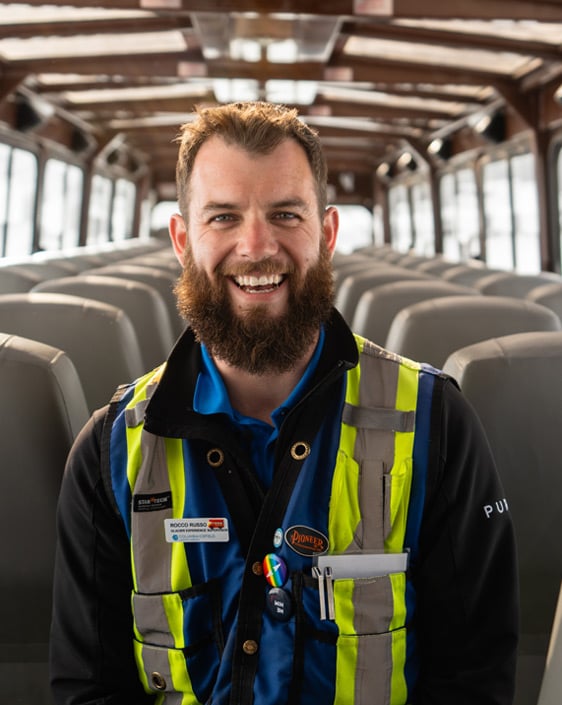
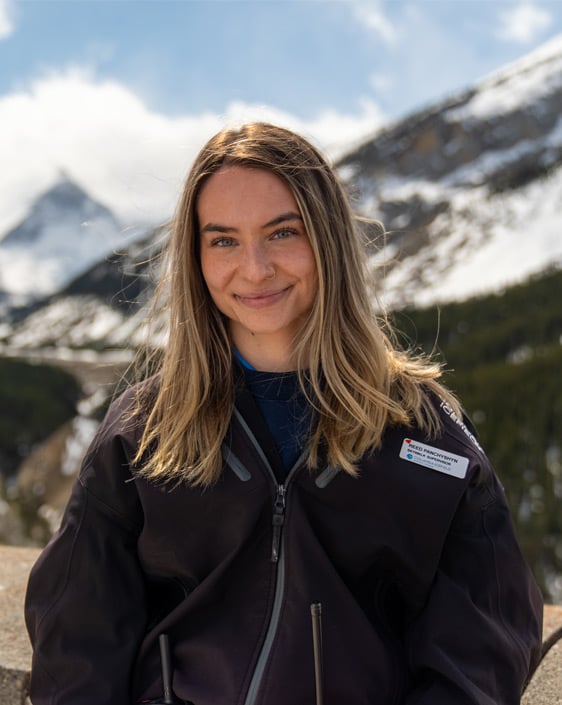
The first step onto the Athabasca Glacier or Columbia Icefield Skywalk is often a moment guests have anticipated for hours, days or even years. So, who gets to tell them all about these spectacular places? That job belongs to folks like Rocco Russo, the glacier experience supervisor, and Reed Panchyshyn, the Columbia Icefield Skywalk supervisor.
“I really like to be able to connect with people on a level that's more than just, ‘the glacier's 200 meters deep,’” says Russo. “I think being able to work here at the Columbia Icefield, I'm so lucky to be able to touch the minds of so many people every single day regarding this beautiful place, but also why it's so important.”
For both Russo and Panchyshyn, the job isn't just about sharing a list of facts — it's about educating guests on what it takes to preserve the natural landscapes they've come to experience at the Columbia Icefield.
“We want people to walk away feeling empowered that they're able to make a change,” says Panchyshyn. “Small little changes, like turning off the lights or using a reusable water bottle or just doing simple things like that on their own.”
That experience translates onto the ice as well. “The glacier itself is indescribable. You can't put this kind of value into words,” says Russo. “Being able to get feet on the ground and hands on the ice really helps people understand why these places are so important and that they are disappearing.”
Russo and Panchyshyn consider themselves lucky to live amongst the glacier, and in their jobs, they aim to communicate the shift in perspective that experiencing this little slice of the world has had on them.
“It's more than just what we do every day. It's how we do it and the lives that we can change in the process,” says Russo. “Every time you turn on the tap for a fresh glass of water, I want you to think, ‘Where did that water come from? What can I do to protect it — not just for me, but for all the future generations still to come?’”
Ready to experience everything Columbia Icefield Adventure has to offer for yourself? Book your visit with the glacier today.

About the author: Amber McLinden is a freelance writer and instructor at Mount Royal University in Calgary, Alberta. She can often be found hiking in the Rockies, planning her next vacation abroad or backcountry camping anywhere without cell service. You can read more of her musings at ambermclinden.com or in her weekly newsletter.
Insider tips, inspiration and deals — delivered straight to your inbox.